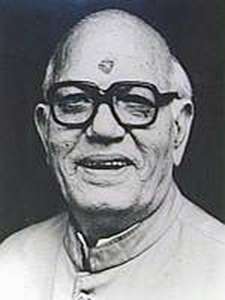Pandit Maniram
Shri Maniram Pandit (8 December 1910 – 16 May 1985)[3] was an Indian classical vocalist from the Mewati gharana. Pandit is known for being the elder brother and guru of Pt. Jasraj and eldest son of Pt. Motiram Pandit.[4][5]
Pandit Maniram | |
|---|---|
 | |
| Background information | |
| Born | 8 December 1910[1] |
| Origin | Pili Mandori, Fatehabad District, Haryana, India |
| Died | 16 May 1985 (aged 74)[2] |
| Genres | Khayal, Bhajan, Thumri |
| Occupation(s) | Vocalist |
| Years active | 1935–1985 |
| Associated acts | Pt. Jasraj, Pt. Pratap Narayan Pandit, Utd. Sultan Khan |
Background
Pandit was born at Pilli Mandori in Haryana to an orthodox Brahmin family with strong musical traditions in the Mewati gharana.[6] His father, Pt. Motiram Pandit, died prematurely in 1939,[7] hours before being announced as Osman Ali Khan's new court musician.[8] After his father died, Maniram Pandit became the patriarch of his family and moved them to Hyderabad where he became a court musician[9] and left deep musical roots.[10]
He began performing professionally at this point in order to support his family. While Maniram's career grew, he began teaching his younger brother, Pratap Narayan, and tabla to his youngest brother, Jasraj.[11]
In 1948, Pandit moved to Calcutta where he lived for two decades.[12][13] In 1963, Pandit moved with his family to Mumbai. There, Pandit met political resistance from other musicians, like S. N. Ratanjankar.[14]
Music
Pandit began training with his father, Motiram Pandit, and uncle, Jyotiram Pandit, at age three until the age of 14.[15] He was regarded for his vocal range and gamaks.[16]
Hyderabad Years (c. 1934-1944)
Pandit's family relocated to Hyderabad as his father was invited to join the Hyderabad Court as a musician.[17]
Sanand Years (1944-1948)
Around 1944, Pandit lost his voice and moved his family to Sanand under the patronage of Jaiwant Singhji Waghela, the maharaj of Sanand, himself a student of the Mewati gharana.[18] There he became the court musician of Sanand.[15]
Pandit spent his time in Sanand focusing on recovery, teaching his brother, Jasraj,[19] and collaborating with Waghela on musical compositions.[8] After regaining his voice during prayer at Sanand, Pandit acquired a renewed sense of spirituality and became a devotee of Durga. Since, emphasis of religious themes became central to Pandit's music, as evident in his compositions.[20]
Performance
Jasraj frequently performed with Maniram from the 1950s onwards. Musicologist Deepak Raja notes that their duets were "rich in melodic content and depth of raga exploration" and "a model of perfect understanding and collaborative effort."[21]
Disciples
Among Pandit's disciples included Pratap Narayan, Jasraj, Bansilal Kapoor,[22] and Girish Wazalwar.
Personal life
Pandit had two sons.[23] His eldest son, Vinod (1952-2001),[24] was a singer who married actress Deepti Naval[25] before dying of cancer.[26] The youngest, Dinesh Pandit is a percussionist, music producer, arranger, and composer based in London.[27][28]
Discography
| Album | Year | Label | Tracks | Featured Musicians |
|---|---|---|---|---|
| Three Illustrious Brothers[29] | 1976 | HMV | 1. Raag Jog - "Piya Ghar Na" (vilambit ektaal), "Meri Gail Nahi Chhode" (druth teentaal) 2. Raag Dhanashri - "Ansua Amol Kanth Birmaye" (vilambit ektaal), "Sakhi Mohe Beet Mata" (druth teentaal) | Pandit Maniram Pandit Pratap Narayan Pandit Jasraj Accompanists: Ustad Nizamuddin Khan (tabla) Ustad Sultan Khan (sarangi) Appasaheb Jalgaonkar (harmonium) |
Awards & Recognition
- 2018 - The Mayor of Mumbai unveiled "Sangeet Mahamahopadhyay Pandit Maniram Marg," a street in Versova, in memory of Pandit. In attendance were Pandit Jasraj, Hridayanath Mangeshkar, Pandit Dinesh, and Jatin-Lalit.[30]
References
- "Pratap Narain Pandit". MyHeritage. Retrieved 9 January 2020.
- Dāśaśarmā, Amala (1 December 1993). Musicians of India: Past and Present : Gharanas of Hindustani Music and Genealogies. Naya Prokash. p. 240.
- "HarmoNYom "A Voice for Indian Classical Music": Tribute! Pt. Maniram and the Mewati Gharana!". 16 November 2010.
- "Maniram Pandit". parrikar.org.
- "Musical night: Pandit Motiram Pandit Maniram Sangeet Samaroh 2016". deccanchronicle.com.
- "Pandit Jasraj". https://www.outlookindia.com/outlooktraveller/. External link in
|website=(help) - "harimohan paruvu: Wadali Brothers at Chowmahalla Palace". 2 December 2013.
- "Pandit Jasraj takes a trip down the memory lane to relive his idyllic childhood spent in Hyderabad | Hyderabad News - Times of India". The Times of India.
- Dāśaśarmā, Amala (1 December 1993). "Musicians of India: Past and Present : Gharanas of Hindustani Music and Genealogies". Naya Prokash – via Google Books.
- Naidu, Jaywant (17 January 2018). "Love to be called Zakir Bhai: Zakir Hussain". Deccan Chronicle.
- "Pt Jasraj: Switched to singing after 'humiliation' with tabla - Times of India". The Times of India.
- "Enlite". Light Publications. 22 August 1969 – via Google Books.
- "Maniram Pandit".
- Pratap, Jitendra (5 November 2009). "The thorn of re-auditioning" – via www.thehindu.com.
- https://3.bp.blogspot.com/-HqE8rM1IAto/V6A6ZtInxEI/AAAAAAAAFP0/o74rrNKDcGYhwFreIOD-tK0euEZoS2aKACLcB/s1600/back.jpg
- "Cultural News from India". Indian Council for Public Relations. 22 August 1980 – via Google Books.
- India, The Hans (3 December 2017). "An ode to music & a city". www.thehansindia.com.
- Sinha, Manjari (3 February 2017). "The maestro's musical odyssey..." – via www.thehindu.com.
- "Pandit Jasraj on his life-long love for music". Hindustan Times. 31 March 2017.
- "Pandit Jasraj". panditjasraj.com.
- Raja, Deepak (23 May 2011). "Deepak Raja's world of Hindustani Music: Pandit Jasraj: the romanticist crusader".
- https://education.siliconindiamagazine.com/vendor/music-saraswati-music-college-cid-310.html
- "Mandhir Pandit". IMDb.
- "Vinod Pandit - Times of India". The Times of India.
- "No qualms about Freaky Chakra: Deepti". www.rediff.com.
- "Expressive interactions". 6 July 2003 – via www.thehindu.com.
- "Jakko Jakszyk". Music-News.com.
- "Acoustic singer Jordan Johnson to launch his Extended Play". 15 March 2018.
- "Pandit Maniram Ji, Pandit Pratap Narayan Ji*, Pandit Jasraj - Three Illustrious Brothers". Discogs.
- "Mumbai Diary: Saturday Dossier". mid-day. 2 June 2018.